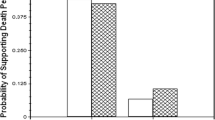Abstract
Responses to a general question regarding the use of the death penalty were compared with the sentences that respondents chose in a set of scenarios describing homicide cases. The percentage of respondents who assigned the death sentence in one or more of the following scenarios was higher than those who favored the death penalty in the abstract question, but there were inconsistencies in the answers. A majority assigned the death penalty only for the most heinous offender described, and the figures were lower for other crimes, even clear cases of first degree murder. At the same time, a manipulation involving information about methods of execution did not affect answers. These results strongly suggest that the abstract questions typically used in public opinion polls do not accurately reflect the public's feelings about use of the death penalty in specific cases. More generally, research on public opinion regarding criminal justice policies should survey a variety of specific circumstances.
Similar content being viewed by others
References
Barnett, A. (1985). Some distribution patterns for the Georgia death sentence.U. C. Davis Law Review,18, 1327–1374.
Bowers, W. J. (1993). Capital punishment and contemporary values: People's misgivings and the Court's misperception.Law and Society, 27, 157–175.
Costanzo, S. & Costanzo, M. (1994). Life and death decisions: An analysis of capital jury decision making under the special issues sentencing framework.Law and Human Behavior, 18, 151–170.
Cox, M. & Tanford, S. (1989). An alternative method of capital jury selection.Law and Human Behavior, 13, 167–183.
Cumberland, J., & E. Zamble (1992). General and specific measures of public attitudes: Release decisions.Canadian Journal of Behavioral Science, 24, 1–14.
Doob, A., & Roberts, J. (1983). Sentencing: An analysis of the public's view.Report to the Department of Justice.
Ellsworth, P.C. (1991). To tell what we know or wait for Godot?Law and Human Behavior, 15, 77–90.
Ellsworth, P.C., Bukaty, R. M., Cowan, C. L. & Thompson, W. C. (1984). The death-qualified jury and the defense of insanity.Law and Human Behavior, 8, 81–93.
Ellsworth, P. C. & Gross, S. R. (1994). Hardening of the attitudes: Americans' views of the death penalty.Journal of Social Issues.50, 19–52.
Finkel, N. J., Hughes, K. C., Smith, S. F. & Hurabiell, M. L. (1994). Killing kids: The juvenile death penalty and community sentiment.Behavioral Sciences and the Law, 12, 5–20.
Fitzgerald, R. & Ellsworth, P. C. (1984). Due process vs. crime control: Death qualification and jury attitudes.Law and Human Behavior, 8, 31–51.
Fox, J. A., Radelet, M. L., & Bonsteel, J. L. (1990–91). Death penalty opinion in the post-Furman years.Review of Law & Social Change, 18, 499–528.
Haney, C., Hurtado, A. & Vega, L. (1994). Modern death qualification: New data on its biasing effects.Law and Human Behavior, 18, 619–633.
Honeyman, J. C. & Ogloff, J. R. P. (1996). Capital punishment: Arguments for life and death.Canadian Journal of Behavioral Science, 28, 27–35.
Kalven, H. & Zeisel, H. (1966).The American Jury. Boston: Little, Brown.
Roberts, J. (1984). Public opinion and capital punishment: The effects of attitudes upon memory.,Canadian Journal of Criminology, 26.
Robinson, R. J. (1993) What does “unwilling” to impose the death penalty mean anyway? Another look at excludable jurors.Law and Human Behavior, 17, 471–477.
Sandys, M. & McGarnell, E. F. (1995). Attitudes toward capital punishment: Preference for the penalty or mere acceptance?,Journal of Research in Crime and Delinquency, 32, 191–213.
Thompson, W. C., Cowan, C. L., Ellsworth, P. C. & Harrington, J. C. (1984). Death penalty attitudes and conviction proneness: The translation of attitudes into verdicts.Law and Human Behavior, 8, 95–113.
Vidmar, N. & Ellsworth, P. (1974). Public opinion and the death penalty.Stanford Law Review, 26, 1245–1270.
Vidmar, N. & Dittenhoffer, T. (1981). Informed public opinion and death penalty attitudes.Canadian Journal of Criminology, 23, 43.
Zamble, E., & K. L. Kalm (1990). General and specific measures of public attitudes toward sentencing.Canadian Journal of Behavioral Science, 22, 327–337.
Author information
Authors and Affiliations
Rights and permissions
About this article
Cite this article
Mills, J., Zamble, E. Public attitudes towards the death penalty. J Police Crim Psych 13, 76–86 (1998). https://doi.org/10.1007/BF02806715
Issue Date:
DOI: https://doi.org/10.1007/BF02806715




